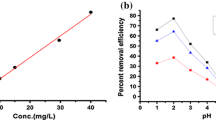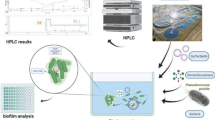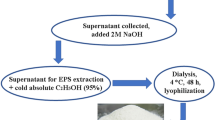Abstract
Globally, the underlying peril of cumulative toxicity of heavy metals in water bodies contaminated by industrial effluents is a matter of great concern to the environmentalists. Heavy metals like lead, cadmium, and nickel are particularly liable for this. Such toxic water is not only hazardous to human health but also harmful to aquatic animals. Remedial measures are being taken by physico-chemical techniques, but most of them are neither eco-friendly nor cost-effective. Biological means like bioaccumulation of heavy metals by viable bacteria are often tedious. In the present study, biosorption of heavy metals is successfully expedited by surfactant exopolysaccharide (SEPS) of Ochrobactrum pseudintermedium C1 as a simple, safe, and economically sustainable option utilizing an easily available and cost-effective substrate like molasses extract. Its efficacy in bioremediation of toxic heavy metals like cadmium, nickel, and lead have been studied by UV–Vis spectrophotometry and verified by inductively coupled plasma–atomic emission spectroscopy (ICP-AES). FTIR and zeta potential studies have also been carried out to explore this novel biosorption potential. Results are conclusive and promising. Moreover, this particular SEPS alone can remediate all these three toxic heavy metals in water. For futuristic applications, it might be a prospective and cost-effective resource for bioremediation of toxic heavy metals in aqueous environment.







Similar content being viewed by others
Data availability
The authors declare that all data generated or analyzed and materials used during the study are mentioned in this article.
References
Abdel-Rahman GN, Ahmed MBM, Sabry BA, Ali SSM (2019) Heavy metals content in some non-alcoholic beverages (carbonated drinks, flavored yogurt drinks, and juice drinks) of the Egyptian markets. Toxicol Rep 6:210–214. https://doi.org/10.1016/j.toxrep.2019.02.010
Ahn SJ, Burne RA (2007) Effects of oxygen on biofilm formation and the AtlA autolysin of Streptococcus mutans. J Bacteriol 189(17):6293–6302. https://doi.org/10.1128/JB.00546-07
Amao JA, Omojasola P, Barooah M (2019) Isolation and characterization of some exopolysaccharide producing bacteria from cassava peel heaps. Scientific African 4:e00093
Behera M, Varade S, Ghosh P, Paul P, Negi A (2014) Foaming in micellar solutions: effects of surfactant, salt, and oil concentrations. Ind Eng Chem Res 53:18497–18507. https://doi.org/10.1021/ie503591v
Belsito DV, Fransway AF, Fowler JF Jr, Sherertz EF, Maibach HI, Mark JG Jr, Mathias CG, Rietschel RL, Storrs FJ, Nethercott JR (2002) Allergic contact dermatitis to detergents: a multicenter study to assess prevalence. J Am Acad Dermatol 46(2):200–206. https://doi.org/10.1067/mjd.2002.119665
Belyaeva EA, Sokolova TV, Emelyanova LV, Zakharova IO (2012) Mitochondrial electron transport chain in heavy metal-induced neurotoxicity: effects of cadmium, mercury, and copper. Sci World J 2012:136063. https://doi.org/10.1100/2012/136063
Bhattacharya M, Biswas D, Sana S, Datta S (2014) Utilization of waste engine oil by Ochrobactrum pseudintermedium strain C1 that secretes an exopolysaccharide as a bioemulsifier. Biocatal Agric Biotechnol 3. https://doi.org/10.1016/j.bcab.2014.09.002
Brera S, Nicolini A (2005) Respiratory manifestations due to nickel. Acta otorhinolaryngologica Italica: organo ufficiale della Società italiana di otorinolaringologia e chirurgia cervico-facciale 25:113–115
Camacho-Chab JC, Castañeda-Chávez M, Chan-Bacab MJ, Aguila-Ramírez RN, Galaviz-Villa I, Bartolo-Pérez P, Lango-Reynoso F, Tabasco-Novelo C, Gaylarde C, Ortega-Morales BO (2018) Biosorption of cadmium by non-toxic extracellular polymeric substances (EPS) synthesized by bacteria from marine intertidal biofilms. Int J Environ Res Public Health 15(2):314. https://doi.org/10.3390/ijerph15020314
Capodici M, Di Bella G, Nicosia S, Torregrossa M (2015) Effect of chemical and biological surfactants on activated sludge of MBR system: microscopic analysis and foam test. Bioresour Technol 177:80–86. https://doi.org/10.1016/j.biortech.2014.11.064
Castellane TC, Otoboni A, Lemos E (2015) Characterization of exopolysaccharides produced by rhizobia. Rev Bras Ciênc Solo 39:1566–1575. https://doi.org/10.1590/01000683rbcs20150084
de Oliveira MPS, de Almeida NF, Leite SG (2008) Application of a bacterial extracellular polymeric substance in heavy metal adsorption in a co-contaminated aqueous system. Braz J Microbiol 39(4):780–786. https://doi.org/10.1590/S1517-838220080004000034
Deguchi H, Aoyama R, Takahashi H, Yoshinari I, Tsutsumi Y (2015) Harmful effects of synthetic surface-active detergents against atopic dermatitis. Case Rep Dermatol Med 2015:898262. https://doi.org/10.1155/2015/898262
Deng Q, Li H, Sun H, Sun Y, Li Y (2016) Hyperbranched exopolysaccharide-enhanced foam properties of sodium fatty alcohol polyoxyethylene ether sulfate. Colloid Surface B 141:206–212. https://doi.org/10.1016/j.colsurfb.2016.01.050
Di Palma L, Petrucci E, Pietrangeli B (2015) environmental effects of using chelating agents in polluted sediment remediation. Bull Environ Contam Toxicol 94:340–344. https://doi.org/10.1007/s00128-014-1437-9
Diep P, Mahadevan R, Yakunin AF (2018) Heavy metal removal by bioaccumulation using genetically engineered microorganisms. Front Bioeng Biotechnol 6:157. https://doi.org/10.3389/fbioe.2018.00157
DuBois M, Gilles KA, Hamilton JK, Rebers PA, Smith F (1956) Colorimetric method for determination of sugars and related substances. Anal Chem 28(3):350–356. https://doi.org/10.1021/ac60111a017
Freitas BG, Brito JG, Brasileiro PP, Rufino RD, Luna JM, Santos VA, Sarubbo LA (2016) Formulation of a commercial biosurfactant for application as a dispersant of petroleum and by-products spilled in oceans. Front Microbiol 7:1646. https://doi.org/10.3389/fmicb.2016.01646
Gugliandolo C, Spanò A, Maugeri T, Poli A, Arena A, Nicolaus B (2015) Role of bacterial exopolysaccharides as agents in counteracting immune disorders induced by herpes virus. Microorg 464-483. https://doi.org/10.3390/microorganisms3030464
Guibaud G, Comte S, Bordas F, Dupuy S, Baudu M (2005) Comparison of the complexation potential of extracellular polymeric substances (EPS), extracted from activated sludges and produced by pure bacteria strains, for cadmium, lead and nickel. Chemosphere 59:629–638. https://doi.org/10.1016/j.chemosphere.2004.10.028
He J, Sun F, Han F, Gu J, Minrui O, Xu W, Xu X (2018) Preparation of a novel polyacrylic acid and chitosan interpenetrating network hydrogel for removal of U(VI) from aqueous solutions. RSC Adv 8:12684–12691. https://doi.org/10.1039/C7RA13065A
Iyer A, Mody K, Jha B (2005) Biosorption of heavy metals by a marine bacterium. Mar Pollut Bull 50(3):340–343. https://doi.org/10.1016/j.marpolbul.2004.11.012
Jardak K, Drogui P, Daghrir R (2016) Surfactants in aquatic and terrestrial environment: occurrence, behavior, and treatment processes. Environ Sci Pollut Res 23:3195–3216. https://doi.org/10.1007/s11356-015-5803-x
Kalita D, Joshi SR (2017) Study on bioremediation of lead by exopolysaccharide producing metallophilic bacteria isolated from extreme habitat. Biotechnol Rep 16. https://doi.org/10.1016/j.btre.2017.11.003
Kang CH, Kwon YJ, So JS (2016) Bioremediation of heavy metals by using bacterial mixtures. Ecol Eng 89:64–69. https://doi.org/10.1016/j.ecoleng.2016.01.023
Kapahi M, Sachdeva S (2019) Bioremediation options for heavy metal pollution. J Health Pollut 9(24):191203. https://doi.org/10.5696/2156-9614-9.24.191203
Kaushik A, Kansal A, Santosh M, Kumari S, Kaushik CP (2009) Heavy metal contamination of river Yamuna, Haryana, India: assessment by metal enrichment factor of the sediments. J Hazard Mater 164(1):265–270. https://doi.org/10.1016/j.jhazmat.2008.08.031
Khan SS, Mukherjee A, Chandrasekaran N (2011) Impact of exopolysaccharides on the stability of silver nanoparticles in water. Water Res 45(16):5184–5190. https://doi.org/10.1016/j.watres.2011.07.024
Krishnamachari P, Hashaikeh R, Tiner M (2011) modified Cellulose Morphologies and its Composites; SEM and TEM analysis. Micron (Oxford, England:1993) 42:751–761. https://doi.org/10.1016/j.micron.2011.05.001
Kumar M, Pandey A, & Thakur I (2019) Genomic analysis of carbon dioxide sequestering bacterium for exopolysaccharides production. Sci Rep 9. https://doi.org/10.1038/s41598-019-41052-0
Lakzian A (2008) Adsorption Capability of lead, nickel and zinc by exopolysaccharide and dried cell of Ensifer meliloti. Asian J Chem 20:6075–6080
Lechuga M, Fernández-Serrano M, Jurado E, Núñez-Olea J, Ríos F (2016) Acute toxicity of anionic and non-ionic surfactants to aquatic organisms. Ecotoxicol Environ Saf 125:1–8. https://doi.org/10.1016/j.ecoenv.2015.11.027
Liang TW, Wu CC, Cheng WT, Chen YC, Wang CL, Wang IL, Wang SL (2014) Exopolysaccharides and antimicrobial biosurfactants produced by Paenibacillus macerans TKU029. Appl Biochem Biotechnol 172(2):933–950. https://doi.org/10.1007/s12010-013-0568-5
Lunkenheimer K, Wantke K (1981) Determination of the surface tension of surfactant solutions applying the method of Lecomte du Noüy (ring tensiometer). Colloid Polym Sci 259:354–366. https://doi.org/10.1007/BF01524716
Mathivanan K, Chandirika JU, Mathimani T, Rajaram R, Annadurai G, Yin H (2021) Production and functionality of exopolysaccharides in bacteria exposed to a toxic metal environment. Ecotoxicol Environ Saf 208:111567. https://doi.org/10.1016/j.ecoenv.2020.111567
Mitchell AM, Mellon MG (2002) Colorimetric determination of nickel with dimethylglyoxime. Ind Eng Chem Anal Ed 17. https://doi.org/10.1021/i560142a012
Mohite BV, Koli SH, Narkhede CP, Patil SN, Patil SV (2017) Prospective of microbial exopolysaccharide for heavy metal exclusion. Appl Biochem Biotechnol 183:582–600. https://doi.org/10.1007/s12010-017-2591-4
Morillo JA, Aguilera M, Ramos-Cormenzana A, Monteoliva-Sánchez M (2006) Production of a metal-binding exopolysaccharide by Paenibacillus jamilae using two-phase olive-mill waste as fermentation substrate. Curr Microbiol 53(3):189–193. https://doi.org/10.1007/s00284-005-0438-7
Mwandira W, Nakashima K, Kawasaki S, Arabelo A, Banda K, Nyambe I, Chirwa M, Ito M, Sato T, Igarashi T, Nakata H, Nakayama S, Ishizuka M (2020) Biosorption of Pb (II) and Zn (II) from aqueous solution by Oceanobacillus profundus isolated from an abandoned mine. Sci Rep 10(1):21189. https://doi.org/10.1038/s41598-020-78187-4
Nowotny A (1979) Carbohydrate determination by phenol-sulfuric acid. In: Basic exercises in immunochemistry. Berlin, Heidelberg: Springer. https://doi.org/10.1007/978-3-642-67356-6_52
Osemwegie OO, Adetunji CO, Ayeni EA, Adejobi OI, Arise RO, Nwonuma CO, Oghenekaro AO (2020) Exopolysaccharides from bacteria and fungi: current status and perspectives in Africa. Heliyon 6(6):e04205. https://doi.org/10.1016/j.heliyon.2020.e04205
Ozdemir G, Ozturk T, Ceyhan N, Isler R, Cosar T (2003) Heavy metal biosorption by biomass of Ochrobactrum anthropi producing exopolysaccharide in activated sludge. Bioresour Technol 90(1):71–74. https://doi.org/10.1016/s0960-8524(03)00088-9
Pandey K, Sengupta R, Bajpai I (2018) 42 rivers have extremely high concentration of neurotoxic heavy metals. https://www.downtoearth.org.in/news/water/huge-amounts-of-toxic-heavy-metals-swim-in-indian-rivers-60545
Raza MH, Sadiq A, Farooq U, Athar M, Hussain T, Mujahid A, & Salman M (2015) Phragmites karka as a biosorbent for the removal of mercury metal ions from aqueous solution: Effect of modification. J Chem 293054. https://doi.org/10.1155/2015/293054
Rezaei H (2016) Biosorption of chromium by using Spirulina sp. Arabian J Chem 9(6):846–853. https://doi.org/10.1016/j.arabjc.2013.11.008
Riva MA, Lafranconi A, D’Orso MI, Cesana G (2012) Lead poisoning: historical aspects of a paradigmatic “occupational and environmental disease.” Saf Health Work 3(1):11–16. https://doi.org/10.5491/SHAW.2012.3.1.11
Santos DK, Rufino RD, Luna JM, Santos VA, Sarubbo LA (2016) Biosurfactants: multifunctional biomolecules of the 21st Century. Int J Mol Sci 17(3):401. https://doi.org/10.3390/ijms17030401
Sardari R, Kulcinskaja E, Ron E, Bjornsdottir S, Fridjonsson O, Hreggvidsson G, Karlsson E (2016) Evaluation of the production of exopolysaccharides by two strains of the thermophilic bacterium Rhodothermus marinus. Carbohydr Polym 156. https://doi.org/10.1016/j.carbpol.2016.08.062
Sengupta D, Datta S, Biswas D (2019) Exploring two contrasting surface-active exopolysaccharides from a single strain of Ochrobactrum utilizing different hydrocarbon substrates. J Basic Microbiol 59(8):820–833. https://doi.org/10.1002/jobm.201900080
Shuhong Y, Meiping Z, Hong Y, Han W, Shan X, Yan L, Jihui W (2014) Biosorption of Cu2+, Pb2+ and Cr6+ by a novel exopolysaccharide from Arthrobacter ps-5. Carbohydr Polym 101:50–56
Sibikina O, Iozep A, Moskvin A (2009) Polysaccharide complexes with metal cations: structure and application (a review). Pharm Chem J 43:341–345. https://doi.org/10.1007/s11094-009-0292-1
Singh R, Gautam N, Mishra A, Gupta R (2011) Heavy metals and living systems: an overview. Indian J Pharmacol 43(3):246–253. https://doi.org/10.4103/0253-7613.81505
Skipper A, Sims JN, Yedjou CG, Tchounwou PB (2016) Cadmium chloride induces DNA damage and apoptosis of human liver carcinoma cells via oxidative stress. Int J Environ Res Public Health 13(1):88. https://doi.org/10.3390/ijerph13010088
Sobrino-Figueroa A (2018) Toxic effect of commercial detergents on organisms from different trophic levels. Environ Sci Pollut Res Int 25(14):13283–13291. https://doi.org/10.1007/s11356-016-7861-0
Tchounwou PB, Yedjou CG, Patlolla AK, Sutton DJ (2012) Heavy metal toxicity and the environment. Exp Suppl 101:133–164. https://doi.org/10.1007/978-3-7643-8340-4_6
Temzi S, Yalaoui-Guellal D, Rodríguez-Carvajal M, Belhadi D, Madani K, Yahia K (2018) Removal of lead by exopolysaccharides from Paenibacillus peoriae strainTS7 isolated from rhizosphere of durum wheat. Biocatal Agric Biotechnol 16. https://doi.org/10.1016/j.bcab.2018.09.016
Tulupov P, Polyanskii N (2007) Thermal stability of anion-exchange resins. Russ Chem Rev 42:754. https://doi.org/10.1070/RC1973v042n09ABEH002730
Tyagi B, Gupta B, Thakur IS (2020) Biosorption of Cr (VI) from aqueous solution by extracellular polymeric substances (EPS) produced by Parapedobacter sp. ISTM3 strain isolated from Mawsmai cave, Meghalaya, India. Environ Res 191: 110064. https://doi.org/10.1016/j.envres.2020.110064
Ullah M, Haque M (2011) Spectrophotometric determination of toxic elements (cadmium) in aqueous Media. J Chem Eng 25. https://doi.org/10.3329/jce.v25i0.7233
Upadhyay A, Kochar M, Rajam MV, Srivastava S (2017) Players over the surface: unraveling the role of exopolysaccharides in zinc biosorption by fluorescent Pseudomonas strain Psd. Front Microbiol 24(8):284. https://doi.org/10.3389/fmicb.2017.00284
Vaishnav A, Upadhyay K, Tipre D, Dave S (2019) Characterization of potent exopolysaccharide producing bacteria isolated from fruit pulp and potato peels and enhancement in their exopolysaccharide production potential. J Microbiol Biotechnol Food Sci 6(3):874–877
Vaishnav A, Upadhayay K, Tipre D, Dave S (2020) Utilization of mixed fruit waste for exopolysaccharide production by Bacillus species SRA4: medium formulation and its optimization. 3 Biotech 10(12):550
Velásquez L, Dussan-G J (2009) Biosorption and bioaccumulation of heavy metals on dead and living biomass of Bacillus spharicus. J Hazard Mater 167:713–716. https://doi.org/10.1016/j.jhazmat.2009.01.044
Ventorino V, Nicolaus B, Di-Donato P, Pagliano G, Poli A, Robertiello A, Iavrone V, Pepe O (2019) Bioprospecting of exopolysaccharide-producing bacteria from different natural ecosystems for biopolymer synthesis from vinasse. Chem Biol Technol Ag 6(18). https://doi.org/10.1186/s40538-019-0154-3
Wang WX (2016) Bioaccumulation and biomonitoring. In Marine ecotoxicology current knowledge and future issues, eds: Blasco J, Chapman PM, Campana O, Hampel M (Cambridge: Academic Press), 99–119
Wang S, Li H, Zhang A, Fang F, Chen Y, Yan P, Jinsong G, Ma T, Shen Y (2020) Importance of exopolysaccharide branched chains in determining the aggregation ability of anammox sludge. Sci Total Environ 734. https://doi.org/10.1016/j.scitotenv.2020.139470
Wei W, Wang Q, Li A, Yang J, Ma F, Pi S, Wu D (2016) Biosorption of Pb (II) from aqueous solution by extracellular polymeric substances extracted from Klebsiella sp. J1: Adsorption behavior and mechanism assessment. Sci Rep 6. 31575. https://doi.org/10.1038/srep31575
Xing Y, Luo X, Liu S, Wan W, Huang Q, Chen W (2020) Synergistic effect of biofilm growth and cadmium adsorption via compositional changes of extracellular matrix in montmorillonite system. Bioresour Technol 315:123742. https://doi.org/10.1016/j.biortech.2020.123742
Yuan C, Xu ZZ, Fan MX, Liu HY, Xie Y, Zhu T (2014) Study on characteristics and harm of surfactants. J Chem Pharma Res 6:2233–2237
Zhang Z, Cai R, Zhang W, Fu Y, Jiao N (2017) A novel exopolysaccharide with metal adsorption capacity produced by a marine bacterium Alteromonas sp. JL2810. Mar Drugs 15(6):175. https://doi.org/10.3390/md15060175
Acknowledgement
The authors remain grateful to (1) Department of Chemical Technology, University of Calcutta; (2) Department of Science and Technology, Govt. of West Bengal (WB-DST); (3) Promotion of University Research and Scientific Excellence (PURSE), Phase II program, Department of Science and Technology (DST), Govt. of India; (4) UGC sponsored Special Assistance Program (SAP), University of Calcutta; and (5) Sophisticated Analytical Instrument Facility (SAIF), IIT Bombay for providing academic and technical support.
Funding
Funding of the entire study was provided by the Department of Science and Technology, Government of West Bengal (WB-DST), India, vide Ref. 115 dated 30/01/2017 and Sanction No. 430 (Sanc.)/ST/P/S&T/15G-7/2016 dated 12/03/2019.
Author information
Authors and Affiliations
Contributions
DS1 conceived and designed the research. DS1, SB4 and SD5 conducted the experiments. DS1 and SD2 analyzed the data. DS1 wrote the manuscript and SD2 supervised the study. SD2 and DB3 provided infrastructural support and contributed new reagents or analytical tools. All authors read and approved the manuscript.
Corresponding author
Ethics declarations
Ethical approval
The study did not involve any animal or human subject.
Consent to participate
The authors give their consent to participate in this research work.
Consent to publish
The authors give their consent to publish this original article.
Conflict of interest
The authors declare that they have no conflict of interest.
Additional information
Publisher's note
Springer Nature remains neutral with regard to jurisdictional claims in published maps and institutional affiliations.
Rights and permissions
About this article
Cite this article
Sengupta, D., Datta, S., Biswas, D. et al. Prospective bioremediation of toxic heavy metals in water by surfactant exopolysaccharide of Ochrobactrum pseudintermedium using cost-effective substrate. Int Microbiol 24, 441–453 (2021). https://doi.org/10.1007/s10123-021-00182-0
Received:
Revised:
Accepted:
Published:
Issue Date:
DOI: https://doi.org/10.1007/s10123-021-00182-0




